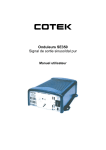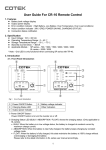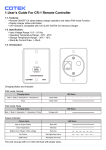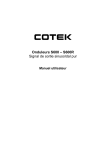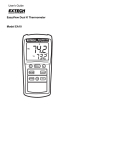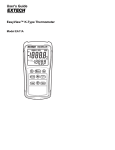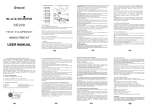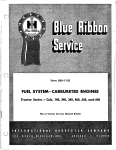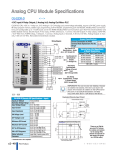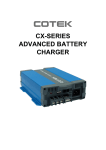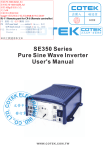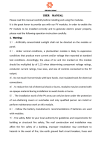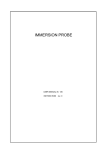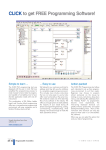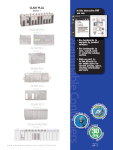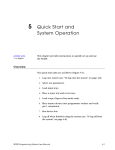Download SE200 User`s Manual
Transcript
SE200 User’s Manual PURE SINE WAVE INVERTER Table of Content 1. IMPORTANT SAFETY INFORMATION 1 1-1. General Safety Precautions 1 1-2. Precautions When Working with Batteries 2 2. FEATURES 3 2-1. Electrical Specification 3 2-2. Mechanical Drawing 5 3. INTRODUCTION 6 3-1. Front Panel 6 3-2. Rear Panel 8 3-3. Protections Features 11 3-4. DC Wiring Connections 11 3-5. AC Safety Grounding 12 3-6. Inverter Installation and Operation 12 4. TROUBLESHOOTING GUIDE 14 5. MAINTENANCE 15 6. INFORMATION 15 1. Important Safety Information Warning! Before installing and using the inverter, you need to read the following safety information carefully. 1-1. General Safety Precautions 1-1-1. Do not expose the inverter to rain, snow, spray, bilge or dust. To reduce risk of hazard, do not cover or obstruct the ventilation openings. Do not install the inverter in a zero-clearance compartment. Over heating may result. 1-1-2. To avoid risk of fire and electronic shock. Make sure that existing wiring is in good electrical condition; and that wire size is not undersized. Do not operate the inverter with damaged or substandard wiring. 1-1-3. This equipment contains components which can produce arcs or sparks. To prevent fire or explosion, do not install in compartment containing batteries or Flammable materials or in locations which require ignition protected equipment. This includes any space containing gasoline-powered machinery, fuel tanks, or joints, fittings, or other connection between components of the fuel system. 1-1-4. Installation The power inverter should be installed in a location that meets the following requirements烉 z Dry – Do not allow water to drip or splash on the inverter. z Cool – Ambient air temperature should be between o o -20 C and 60 C, cooler the better. z Safe – Do not install in a battery compartment or other areas where flammable fumes may exist, such as fuel storage areas or engine compartments. z Ventilated – Allow at least one inch of clearance around the inverter for air flow. Ensure the ventilation openings on the rear and front of the unit are not obstructed. 1 z Dust – Do not install the inverter in a dusty environments where are dust, wood particles or other filings / shavings are present. The dust can be pulled into the unit when the cooling fan is operating. z Close to batteries – Avoid excessive cable length and make sure not to install the inverter in the same compartment as batteries. Use the recommended wire length and size (refer to 3-4). Also do not mount the inverter where it will be exposed to the gases produced by the battery. These gases are very corrosive and prolonged exposure may damage the inverter. Warning! Shock Hazard. Before proceeding further, carefully check that the inverter is NOT connected to any batteries, and that all wiring is disconnected from any electrical sources. Do not connect the output terminals of the inverter to an incoming AC source. Warning! Do not open or disassemble the Inverter. Attempting to do so may cause risk of electrical shock or fire. 1-2. Precautions When Working with Batteries 1-2-1. If battery acid contacts skin or clothing, immediately wash with soap and water. If acid enters eye, immediately flood eye with running cold water for 20 minutes at least and get medical attention immediately. 1-2-2. Never smoke or allow a spark or flame in vicinity of battery or engine. 1-2-3. Do not drop a metal tool on the battery. The resulting spark or short-circuit on the battery of other electrical part may cause an explosion. 2 1-2-4. Remove personal metal items such as rings, bracelets, necklaces, and watches when working with a lead-acid battery, A lead-acid battery produces a short-circuit current high enough to weld a ring or the like to metal, causing a severe burn. 2. Features z z z z z z z z Pure sine wave output Power ON / OFF remote control (Green terminal) Wide input range烉10~16VDC(112/212), 20~32VDC(124/224) Wide operating temperature烉-20ɗġ ~ +60ɗ Input & output fully isolation Output frequency 50 / 60Hz selectable by DIP switch Output voltage / power saving mode selectable Input Protection: Reverse Polarity (Fuse ) / Under Voltage / Over Voltage Protection z Output Protection: Short Circuit / Overload / Over Temperature Protection z Power saving function z FCC class B approved 2-1. Electrical Specification MODEL AC Voltage Output SE200-112 SE200-124 SE200-212 SE200-224 100 / 110 / 115 / 120VAC ±5% 200 / 220 / 230 / 240VAC ±5% Rated Power Over Rated Power (3 Min.) Peak Power (3 Sec.) Waveform 200VA (@rated VDC, linear THD < 3.0% 230VA 250VA load) Frequency DC Voltage Voltage Range Input Efficiency ( Typ. ) No load power consumption 50 / 60Hz ±0.5% (selectable via Dip switch) 12VDC 24VDC 12VDC 10.0~16.0VDC 20.0~32.0VDC 10.0~16.0VDC 24VDC 20.0~32.0VDC 89% 91% 91% 93% @12VDC @24VDC @12VDC @24VDC 3 Input Protection MODEL On mode @ save mode On mode @ no load mode SE200-112 SE200-124 SE200-212 SE200-224 < 0.12A < 0.06A < 0.12A < 0.06A < 0.5A < 0.4A < 0.5A < 0.4A BAT. Low Shutdown 10.0VDC ± 3% 20.0VDC ± 3% 10.0VDC ± 3% 20.0VDC ± 3% BAT. Low Alarm 10.5VDC ± 3% 21.0VDC ± 3% 10.5VDC ± 3% 21.0VDC ± 3% BAT. Low Restart 12.5VDC ± 3% 25.0VDC ± 3% 12.5VDC ± 3% 25.0VDC ± 3% BAT. High Alarm 15.5VDC ± 3% 31.0VDC ± 3% 15.5VDC ± 3% 31.0VDC ± 3% BAT. High Shutdown 16.0VDC ± 3% 32.0VDC ± 3% 16.0VDC ± 3% 32.0VDC ± 3% BAT. High Restart 14.5VDC ± 3% 29.0VDC ± 3% 14.5VDC ± 3% 29.0VDC ± 3% Protection Overload , Short circuit , DC over / under voltage , Over temperature DC Input Reverse Polarity By Fuse Working Temp. -20ʚ ~ +60ʚ Environment Storage Temp. -30ʚ ~ +70ʚ Working Humidity Safety Standards Safety & EMC EMC Standards E-mark Max. 90% , RH non-condensing --- Certified EN 60950-1 Certified FCC Part15 Class B Certified EN55022 Certified EN61204-3 Certified EN61000-6-3 Certified EN61000-3-2 Certified EN61000-3-3 Certified EN55024 Certified EN61000-6-1 Certified EN61000-4-2, 3, 4, 5, 6, 8, 11 --- Certified CISPR 25; ISO 7637-2 Dimension (WxHxD) 150x68x187 mm (5.91x2.68x7.36 inch) Others Packing 1.6kg; 6pcs / 10.6kg / 1.45CUFT Cooling Load and temperature control fan Application Home and Office applications, Portable Power Equipment, Vehicle, Yacht and Off-Grid Solar power systems …etc. Table 1. Electrical Performance Note: 1. The specifications are subject to change without notice. 2. This test condition is normal DC input and temperature 25ɗ. 4 2-2. Mechanical Drawing Unit烉mm [inch] Fig. 1. Mechanical drawing 5 3. Introduction This power inverter series is a member of the most advanced line of mobile AC power systems available. To get the most out of the power inverter, it must be installed and used properly. Please read the instructions in this manual before installing and operating this model. 3-1. Front Panel Fig. 2. SE200 front panel Main switch AC output socket Status LED Function switch Table 2. SE200 front panel 3-1-1. Main switch 烉ON / OFF / REMOTE main switch. 3-1-2. Status LED 烉display power & fault status Status Power on Normal 6 LED Signal Description Beep twice, LED shows red Æ orange Æ green Æ green LED lights in solid green Status LED Signal Description LED flashes green condition in intermediate condition once every 2 seconds LED lights red; following two short beeps. Inverter shuts down after 3 minutes and restart 3 times. LED lights red; following two short beeps. Inverter shuts down after two seconds and restart 3 times. LED flashes red light quickly twice every 1.6 seconds LED flashes orange light slowly with 5 short beeps every 15 seconds LED flashes red light every 0.4 seconds, then inverter shuts down. LED flashes orange light every 0.1 seconds LED flashes red light every 0.1 seconds, then inverter shut down. LED flashes red light slowly once and quickly twice every 1.6 seconds Saving mode O/P over load O/P short circuit Over temperature Under alarm voltage Shut down under voltage Over voltage Shut down over voltage Fan alarm Troubleshooting Guide烉refer to section 4. Note烉LED Status G=Green R=Red Table 3. LED Status O=Orange 7 3-1-3. AC output socket (available options) Table 4. AC output socket 3-1-4. Function switch 烉to set power saving on / off, AC output frequency & AC output voltage烉 Power Saving ON OFF Dip Switch 1 0 Table 5. Dip switch setting-power saving Frequency 50 HZ 60 HZ Dip Switch 0 1 Fig. 3. Function switch Table 6. Dip switch setting-frequency Output Voltage 100VAC (200VAC) 110VAC (220VAC) 115VAC (230VAC) 120VAC (240VAC) S1 0 0 1 1 S2 0 1 0 1 Table 7. Dip switch setting-output voltage 3-2. Rear ar Panel Fig. 4. SE200 rear panel 8 Green terminal Chassis ground Remote port (RJ-11) DC input connector Table 8. SE200 rear panel 3-2-1. Green terminal 烉using green terminal to ON / OFF the inverter. When user connect green terminal, the unit will set green terminal is first priority. PIN Num. 1 2 3 Fig. 5. SE200 green terminal Signal Description GND ENB ENB Table 9. Green terminal setting MODE I Fig. 6. Green terminal-mode 1 MODE II TR烉VCEO > VBAT Fig. 7. Green terminal-mode 2 MODE III Fig. 8. Green terminal-mode 3 MODE IV Fig. 9. Green terminal-mode 4 Battery voltage please follows inverter input voltage. 9 3-2-2. Remote port (RJ-11) 烉 2 1. Use 0.75mm cable to connect the remote port and CR-8. 2. Use CR-8(optional remote control panel) to ON / OFF the inverter. Fig. 10. Remote port SE200 CR-8 (optional) PIN Num. Signal Description Signal Description PIN Num. 1 Not used Not used 1 2 GND GND 2 3 Not used Not used 3 4 Not used Not used 4 5 ENB ENB 5 6 Not used Not used 6 Table 10. Remote port 3-2-3. Chassis ground chassis. 烉use # 8 AWG wire to connect vehicle Warning! Operation of the inverter without a proper ground connection may result in an electrical safety hazard. 3-2-4. DC input connector 烉 Connect to 12V / 24V battery or the other power sources. ˰為˱ is positive. ˰炼˱is negative. Reverse polarity connection will blow internal fuse and may damage inverter permanently. Model 12V 24V DC Input Voltage Minimum Maximum 10.0 16.0 20.0 32.0 Table 11. DC input voltage 10 3-3. Protections Features Over Temperature DC Input (VDC) Model Over Voltage Shutdown Restart Protection Under Voltage Under Voltage Shut- Alarm down INTERIOR Shut- Restart down Restart 12V 16V±3% 14.5V±3% 10.5V±3% 10.0V±3% 12.5±3% 90±3ɗ 50±3ɗ 24V 32V±3% 29V±3% 21.0V±3% 20.0V±3% 25.0±3% 90±3ɗ 50±3ɗ Table 12. Protections Features Note烉The specifications are subject to change without notice. 3-4. DC Wiring Connections Follow this procedure to connect the battery cables to the DC input terminals of the inverter. Your cables should be as short as possible (Ideally, less than 6 feet / 1.8 meters, apply both 120V and 230V versions) enough to handle the required current in accordance with the electrical codes or regulations application. Cables are not an adequate gauge (too narrow) or too long will decrease the inverter performances such as poor surge capability or causing frequent low input voltage warnings and shutdowns. UVP warning presents due to DC voltage drop across the cables from the inverter to the batteries. The longer or narrower the cables, the greater the voltage drop. Increasing your DC cable size will help improve the situation. Warning! The installation of a fuse must be on positive cable. Failure to place a fuse on “+” cables running between the inverter and battery may cause damage to the inverter and will void warranty. Fig. 11. Fuse installation 11 3-5. AC Safety Grounding The AC output ground wire should go to the grounding point for your loads (for example, a distribution panel ground bus). Ground Fault Circuit Interrupters (GFCI)烉 Installations in Recreational Vehicles (for North American approvals) will require GFCI protection of all branch circuit connected to the AC output of the hardwire terminal equipped inverter. In addition, electrical codes require GFCI protection of certain receptacles in residential installations. While the pure sine wave output of the inverter is equivalent to the waveform provided by utilities, compliance with UL standards requires us to test and recommend specific GFCI. COTEK has tested the following GFCI – protected 20A receptacles and found that they functioned properly when connected to the output of the inverter. Warning! Risk of electronic shock. Recommend GFCI connector烉 z HUBBELL INC WIRING DEVICE DIV, Type GF20. Rated 125V, 20A z COOPER WIRING DEVICES, Type VGF20. Rated 125V, 20A z LEVITON MFG CO INC, Type 7899-W. Rated 125V, 20A Others may fail in operating the inverter when connecting to the inverter’s equipment. 3-6. Inverter Installation and Operation Before installing the inverter, make sure the main switch must be “OFF”. STEP 1. Connect the DC cable, then connect the DC cable to battery. (Make sure the polarity) Fig. 12. Installation step 1 12 STEP 2. Dip switch setting for AC output voltage, frequency, and saving mode. (Refer to 3-1-4.) Fig. 13. Installation step 2 STEP 3. Connect the AC cable. Fig. 14. Installation step 3 STEP 4. Power ON. The buzzer will send out “Beep” sounds at the moment the inverter will do self-diagnosis, then the power status Fig. 15. Installation step 4 LED indicators will also appear in various colors. Finally the buzzer will sound another “Beep” and the power status LED indicators will turn to solid “Green” color (normal state), means the inverter is now ready to work. Note: 1. If there is several loads used, turn them on separately after the inverter has been “ON” in order to prevent the OVP present caused by the surge power. 2. Set power inverter switch to the ON position and turn the test load on. The inverter should supply power to the load. If you 13 plan to accurately measure the true output r.m.s. voltage of inverter, a meter such as FLUKE 45 BECKMAN 4410 or TRIPLETT 4200 must be used. 4. Troubleshooting Guide Warning! Do not open or disassemble the inverter. Attempting to service the unit yourself may result in a risk of electrical shock or fire. Status O/P over load O/P short circuit Over temperature Under voltage alarm Shut down under voltage Over voltage Shut down over voltage Fan alarm LED Signal LED lights red; following two short beeps. Inverter shuts down after 3 minutes and restart 3 times. LED lights red; following two short beeps. Inverter shuts down after two seconds and restart 3 times. LED flashes red light quickly twice every 1.6 seconds Reduce load. LED flashes orange light slowly with 5 short beeps every 15 seconds LED flashes red light every 0.4 seconds, then inverter shuts down. LED flashes orange light every 0.1 seconds 1. Check connections and cable. 2. Recharge battery. LED flashes red light every 0.1 seconds, then inverter shut down. LED flashes red light slowly once and quickly twice every 1.6 seconds Check input voltage. Reduce input voltage. Please turn on Table 13. Troubleshooting Guide 14 Solutions In case of restart failed, please turn on the unit manually. Check AC wiring, make sure no circuit. In case of restart failed, please turn on the unit manually. Improve ventilation. Make sure ventilation openings in inverter are not obstructed. Reduce ambient temperature. Recharge battery. Check connections and cable. Please turn on the unit manually. Check input voltage. Reduce input voltage to meet SE200. the unit manually. 1. Check fan connection wire 2. Clean the dust on the fan 5. Maintenance Very little maintenance is required to keep your inverter operating properly. You should clean the exterior of the unit periodically with a damp cloth to prevent accumulation of dust and dirt. At the same time, tighten the screws on the DC input terminals. 6. Information We guarantee this product against defects in materials and workmanship for a period of 24 months from the date of purchase. In case you need to repair or replace any defective power inverters, please contact COTEK local distributor. This warranty will be considered void if the unit has been misused, altered, accidentally damaged, or disassembled. COTEK is not liable for anything that occurs as a result of the user’s fault. 15 No.33, Sec. 2, Renhe Rd., Daxi Dist., Taoyuan City 33548, Taiwan Phone烉+886-3-3891999 FAX烉+886-3-3802333 http烉// www.cotek.com.tw 2015.04._A0




















